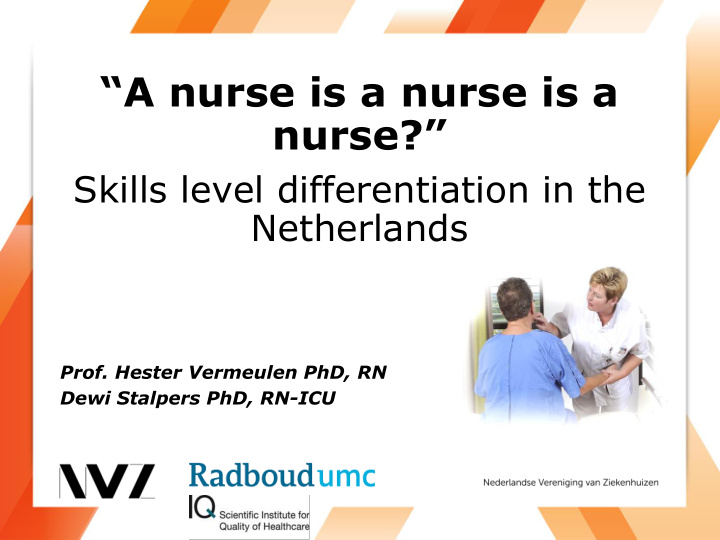



“A nurse is a nurse is a nurse?” Skills level differentiation in the Netherlands Prof. Hester Vermeulen PhD, RN Dewi Stalpers PhD, RN-ICU
Short introduction ICU nurse, St. Antonius Nurse, Academic • • Medical Center (AMC) Hospital Master Evidence Based Master Health Sciences • • Practice; Clinical Epidemiology PhD Excellent Care • PhD Evidence Based • Postoperative Care Advisor/researcher • Dutch Hospital Association (NVZ) Professor Radboud • University/ IQ healthcare
Aim of the presentation • Overview current Dutch nursing workforce • Future perspectives • Impact on all health care fields, we focus on hospitals
Health care workforce in the Netherlands
Nursing workforce • ± 180.000 nursing professionals • ± 80.000 in hospitals EQF (Europe)> NLQF (Netherlands) • NLQF 2/3: Nurse assistant • NLQF 4: Vocational level nurse • NLQF 6: Bachelor level nurse • NLQF 7: Nurse specialist/Physician Assistant • NLQF 7/8: Academic nurse (Master/PhD)
Current developments • Since 2012 awareness to look at current and future Dutch workforce • Research of e.g., RN4CAST: Staffing and skill-mix • Nurse-sensitive patient outcomes • (Patient safety & Care Left Undone) Nurse outcomes • (Burnout, intention to leave)
Changes in society From now to 2030 • More complex patients (age, multi-morbidity) • More chronic, psychic and psych-social problems • Emphasis on chain care (intersectional/ inter- professional) • Centralisation of high-technology and complex care in hospitals
Changes in patient approach Positive health • Focus on functioning instead of the disease • Biomedical to biosocial model New definition (Machteld Huber): “ The ability to adapt and to self manage in the light of the physical, emotional and social challenges of life "
Changes for professionals Future developments in health care • Professional competence • Collaborative ability • Permanent learning capacity • Role for technology
Quality impulse (KiPZ) Quality Impulse Hospital Personnel (2014-2017) “Recruit and retain skilled and engaged workforce by • allowing an extra boost to the qualifications and training of employed professionals” Subsidy from Department of Health, Welfare & Sports • Strategic planning of personnel and training • CPD: E-Health, renew skills, practice labs • upgrade education level, EBP implementation
Recent debates • Education, staffing, skillmix • Nurses NLQF 4 & 6: In nursing practice equal functions • Equal nursing procedures • • Advice to make a differentiation: NLQF 4 nurse • NLQF 6 nurse • Amendment of the law in 2018/2019 • https://peppermint.wistia.com/medias/l5nula9dxi
Consequences
Job profiles Actually differentiate in practice NLQF 4 nurse NLQF 6 nurse Optimization care Optimization care • • process patient process patient group Coordinates nursing Coordinates nursing • • aspects around aspects surrounding individual patients patient flows Provides contribution to Initiates and monitors • • quality of nursing care quality of care (eg (eg workgroup) setting up research)
Coaching Clinical reasoning Evidence Based Practice https://www.nvz- ziekenhuizen.nl/onderwerpen/functiediffer entiatie-mbo-en-hbo-verpleegkundigen
Nurse Sensitive Outcomes Evidence Based Guidelines Skill-mix - Patient - MBO, (post-)HBO - Professional Nursing process - (post-) academic - Organizational - Assessment, diagnosis, outcomes, planning, Continu Prof Development implementation, evaluation - formal & informal
Earlier research
So we have to move from…. to…
Fig. 2 High Performing Organizations Natalie Taylor, Robyn Clay-Williams, Emily Hogden, Jeffrey Braithwaite and Oliver Groene High performing hospitals: a qualitative systematic review of associated factors and practical strategies for improvement. BMC Health Services Research201515:244
Empirical framework Patient outcomes Demand for care · Complications · Patient characteristics · Nurse sensitive outcomes age, gender, comorbidity, etc. · Satisfaction and patient · Number of patients reported outcome measures (PROMS) Staffing Processes on ward level Personnel outcomes · Care-givers (what really happened; non ·Job satisfaction age, gender, experience, predictable; erratic) ·Absenteeism ·Patient care intensity employment status ·Burnout · Number of care-givers ·Staffing utilization level ·Professional practice · Skill mix ·Percieved work environment Organizational outcomes ·Quality of care Organization of care ·Costs Caregivers’ workload · Organizational characteristics type, size, technology · Structures, models and conditions for providing care Feedback Modified from O’Brien -Pallas et al., J Clin Nurs. 2011;20:1640-1650
Clinical Academic Career Pathways Catharina van Oostveen, RN PhD, Prof. Hester Vermeulen
Clinical Academic Career Pathways Now • Lack of career possibilities • Recruitment and retention not optimal • Not an optimal infrastructure for research • Knowledge drain Desired combination of core tasks P • Research & Practice • Practice & Education • Education & Reseach R E
Clinical Academic Career Pathways Nursing Career Path in Research Clinical academic training pathway at the NIH Clinical Center, America of the University of Southampton
A Dutch version of CA Pathways - Visualize the career opportunities for nurses - Contribute to the development of clinical academic nurses - Increase image of hospital as an attractive employer - Increase staff retention which reduce labour cost - No waste of talent! P R E
Skills level differentiation Not a goal in itself, but a mean… • …to optimize quality of patient care • …to provide good work environments in which all nurses excel on their own level • …to create efficient and collaborative teams
Thank you for your attention!
Recommend
More recommend